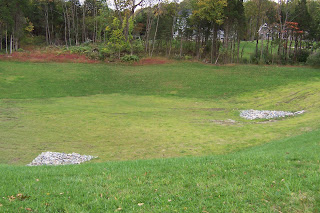Detention Basins: The Good, the Bad, and the Ugly


In our area, stormwater sewers that serve housing developments and some businesses empty into the dreaded detention (or retention, or infiltration) basin, a visually hideous engineered method of holding large volumes of water until it can safely disperse to groundwater, natural streams, ponds, etc. (top photo). These are generally grass monocultures or rip rap which, if not properly maintained become weedy, overgrown maintenance nightmares. Suffice it to say that anyone who can get away with not maintaining one will continue to not maintain it. Frequently, the town ends up owning and maintaining such basins, meaning that all the taxpayers pay.
When grass is used as the only groundcover and pesticides and fertilizers are applied, they can contaminate the runoff. Regular mowing of the basins is difficult because of the steep sides and wet floor. This maintenance adds contaminants to the watercourse, as well. Grass basins also attract undesirable wildlife, such as Canada Geese, which prefer this open environment and add excess organic waste to the runoff.
One of my life's missions is to eradicate this type of detention basin first, from my own town, then from the state of New Jersey, and then from the face of the Earth, replacing them instead with stormwater gardens. A stormwater garden is NOT a rain garden. The scale and purpose are vastly different. Rain gardens are more like an alternative to a drywell, or a bog garden that operates on your roof runoff (I have one), but they absolutely are not designed to handle the runoff, for example, from a steeply sloping 5-acre lot, or from ten 2-acre lots.
New Jersey DEP's preferred Best Management Practice for detention/retention/infiltration basins is a vegetated stormwater garden, also called a Marsh Meadow Garden. For anyone close to Morristown, NJ, such a sustainable garden serves the vast parking lot of the the Frelinghuysen Arboretum (bottom photo). For those who are not, Chapter 7 of the NJDEP Stormwater Best Management Practices Manual can be downloaded from the NJDEP website: www.state.nj.us/dep/
Since a detention basin is one place where grass is NOT needed and maintenance is difficult, a more varied and suitable combination of plants can be used. Unlike grass, the plants used here do not require constant maintenance, pesticide treatments, or fertilizer applications. Therefore the basin is more energy and cost efficient. The dense plantings act as a buffer and perform the valuable functions of biofiltration and erosion control. Canada Geese are deterred by the thick cover, which attracts a great diversity of other desirable wildlife.
Stormwater gardens that use native plants offer a more attractive, low/no maintenance, and habitat-conserving alternative to the monoculture detention basins that drive out native species of both plants and animals.
You may also like to read about the Sustainable Gardening Library here.
Browse the Sustainable Gardening Library's Stormwater Management content HERE

